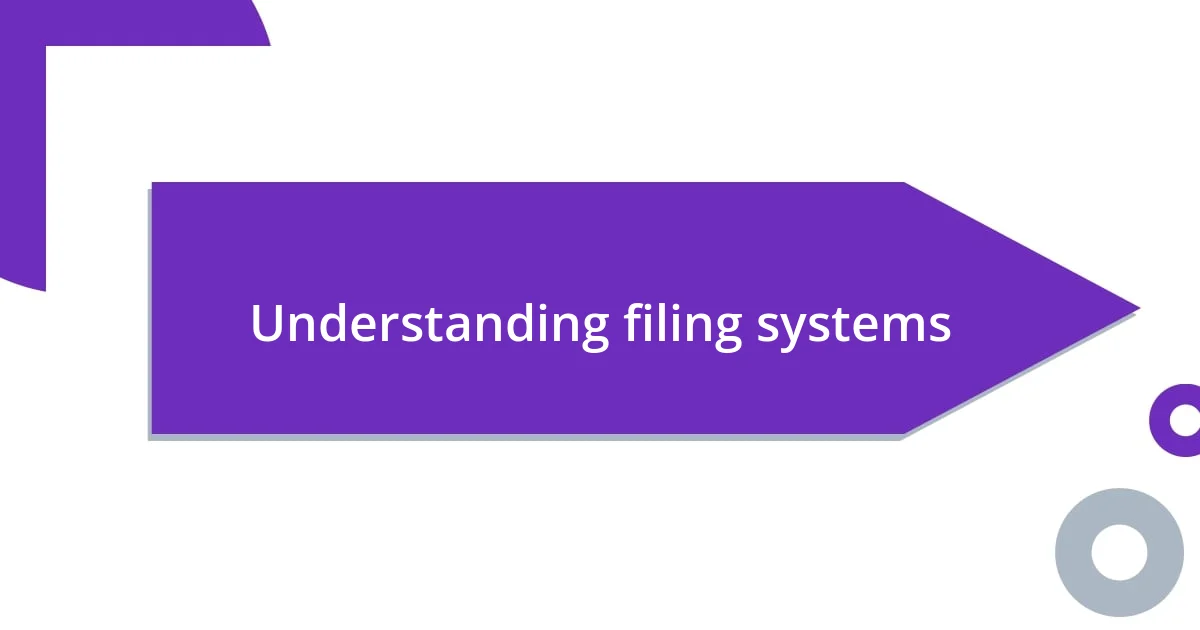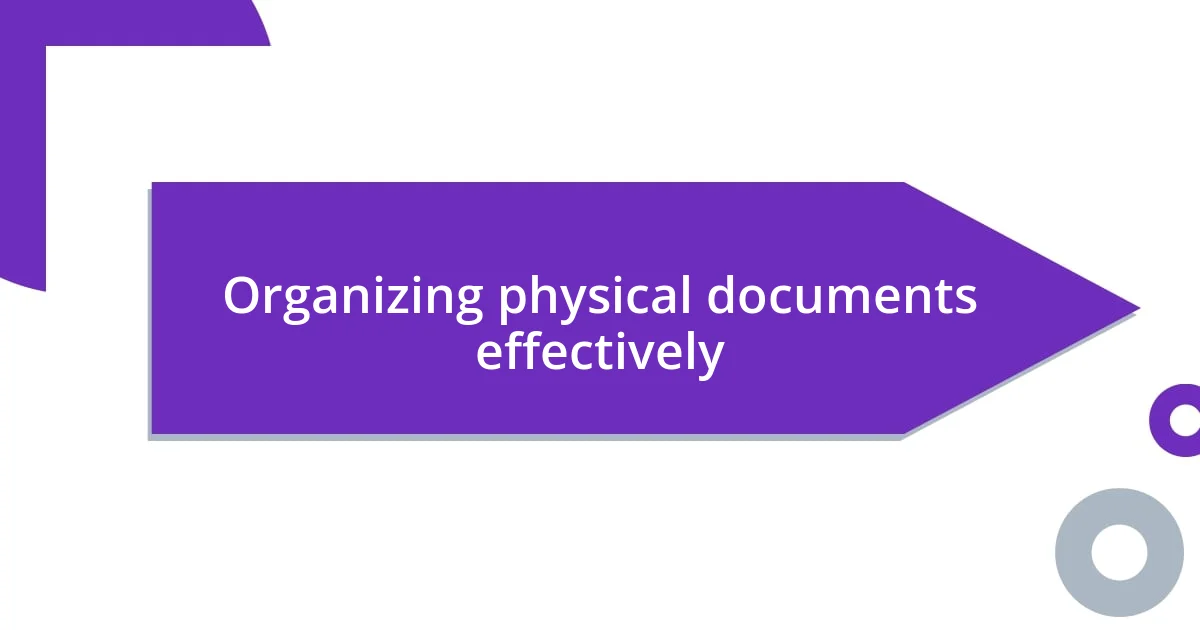Key takeaways:
- Creating a personalized filing system focused on simplicity and accessibility can significantly reduce clutter and enhance productivity.
- Utilizing various methods like digital filing, color-coding, and descriptive labels can streamline document retrieval and make organizing enjoyable.
- Regular reviews and flexibility in your filing approach are crucial for maintaining an effective system that evolves with your needs.

Understanding filing systems
Understanding filing systems is about more than just organizing papers; it’s about creating a system that truly works for you. I remember when I first attempted to sort all my documents—there were piles everywhere, and I felt completely overwhelmed. By asking myself what truly mattered in my filing system, I realized I needed to prioritize simplicity and accessibility.
When I think about my filing system now, I reflect on the emotional weight that clutter can carry. Every time I open a drawer filled with disorganized papers, I feel a sense of unease. A well-structured filing system eases that tension and helps bring clarity to my mind, allowing me to approach other tasks with more confidence. Have you ever noticed how a neat workspace can boost your mood?
Moreover, the beauty of a tailored filing system is that it can adapt to your specific needs. For example, I once categorized my files by project, and it made accessing the information I needed much faster during meetings. Each adjustment I made not only improved my organization but also gave me a sense of accomplishment. What changes resonate with you when you think about your own system?

Choosing the right filing method
Choosing the right filing method can be a game changer. Over the years, I’ve tried various methods—some worked better than others. I remember when I switched from a traditional paper filing system to a digital one; it was liberating. The ability to access documents from anywhere reduced my stress significantly. Have you ever felt that instant relief when you find a document exactly when you need it?
Another method I’ve experimented with is color-coding. It might sound trivial, but using different colors for different categories brought an unexpected joy to my filing process. It feels like arranging a creative puzzle where each piece has its place. This small change not only made retrieval easier but also turned a mundane task into something enjoyable. Do you think a little creativity can spark joy in your own filing system?
Ultimately, the best method is the one that aligns with your workflow. While some may thrive with a chronological system, others might prefer to file by topic or project. I learned that understanding my unique workflow made all the difference. Have you assessed how your current approach fits with the way you operate?
| Filing Method | Description |
|---|---|
| Traditional Paper | Organizing physical documents in folders or cabinets. |
| Digital Filing | Storing documents electronically for easy access and backup. |
| Color-Coding | Using colors to categorize files for quick identification. |
| Chronological | Arranging documents based on date for a timeline perspective. |
| Topical/Project-Based | Organizing files based on specific projects or subjects. |

Organizing physical documents effectively
One essential aspect of organizing physical documents effectively is creating a clear and intuitive system. I remember the first time I opened my filing cabinet after adopting a straightforward alphabetical arrangement. It felt almost like a breath of fresh air! Suddenly, I could find the documents I needed without digging through layers of confusion. This approach not only minimized my frustration but also inspired confidence during important meetings.
To maintain physical documents effectively, I recommend implementing a few strategies that have worked wonders for me:
- Use Descriptive Labels: Rather than vague titles, I choose specific labels that give immediate context, like “2022 Tax Returns” instead of just “Taxes.”
- Regularly Purge: I set aside time each month to eliminate outdated or unnecessary documents. It’s amazing how liberating it feels to declutter!
- Establish a Home Base: Designate a primary location for essential documents, like my passport or birth certificate, ensuring they’re always easy to find.
- Utilize Vertical Storage: Investing in vertical file organizers has made a significant difference in space management, keeping my desk area tidy.
Finding that balance between comfort and efficiency in my filing system has truly transformed the way I handle paperwork. Keeping surfaces clear and knowing where everything lives fosters a sense of peace in my workspace. I’d love to hear how you approach maintaining your own physical documents!

Digital filing system essentials
When it comes to a digital filing system, simplicity is crucial. I found enormous relief when I started using a straightforward naming convention for my files. Instead of cryptic names, I opted for clear, descriptive titles like “ProjectABCPresentation_June2023.” This little tweak made a world of difference! How often do we wrestle with vague file names that lead us down rabbit holes of frustration?
Another key element is a well-organized folder structure. I remember when I created a hierarchy that mirrored my projects and workflows. By setting up main folders and subfolders, I gained control over my documents, making everything logical and easy to locate. It was like transforming my digital chaos into a serene workspace. Can you recall the last time you felt completely at ease while navigating your files?
Regular backups are vital for digital filing systems. Early on, I learned this the hard way when I lost important files due to a system crash. Now, I have automated backups set up, ensuring my files are secure. This simple precaution alleviates my anxiety around losing crucial information. Have you taken steps to safeguard your vital documents?

Customizing your filing approach
Customizing your filing approach goes beyond mere organization; it’s about tailoring your system to fit your unique preferences and workflows. I discovered that color-coding my folders brought a delightful vibrancy to my workspace. Instead of being stuck with a drab filing system, I now associate certain colors with specific categories, such as green for finance and blue for projects. This little tweak not only makes retrieval faster, but it also adds a splash of joy to my day—especially when paperwork starts to pile up.
One strategy that has enhanced my filing approach is creating personalized templates for frequently used documents. I remember how tedious it was to start from scratch every time I needed to draft a specific report or application. By customizing templates to fit my style and needs, I’ve made the process smoother and more efficient. It’s like having a workflow that anticipates my needs, allowing me to focus on the content instead of formatting. Have you ever felt bogged down by repetitive tasks? Custom templates could be your answer.
Lastly, I’ve learned that the most effective filing systems evolve over time. My current setup looks vastly different from what it was a year ago. Initially, I clung to a rigid structure, but I found that embracing flexibility was key. Each month, I review what’s working and what isn’t, making adjustments to reflect my current projects. Do you take the time to assess your system periodically? I’ve found that this approach not only keeps things functional but also keeps me engaged with my filing system, preventing the monotony that can lead to a cluttered workspace.

Reviewing and improving your system
When I first started refining my filing system, I found real value in setting aside dedicated time to review it regularly. I remember that moment when I took a Friday afternoon to go through my folders; it felt like a mini retreat. I discovered outdated files and redundancies that cluttered my workspace. Don’t you ever feel the relief that comes from letting go of excess baggage?
One effective method I’ve adopted is conducting a monthly check-in. I jot down notes about what worked well in the previous month and what could use a bit of sprucing up. I’ve noticed that this proactive approach not only keeps my filing system fresh but also sparks creativity—I often brainstorm new categories or organization strategies during these sessions. Have you ever had insights strike you unexpectedly while engaging in seemingly mundane tasks? It’s a reminder that reflection can bring about innovation.
I also started gathering feedback from peers about my system. Sharing my approach, I felt a sense of camaraderie and connectedness. Their tips and experiences led to valuable changes that improved my organization even further. Engaging with others can breathe new life into our routines, don’t you agree? It’s fascinating how collaboration often unveils new ideas that we may not have considered alone. When was the last time you reached out for insights on your filing practices?












